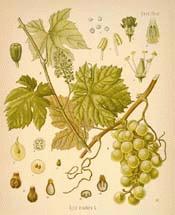
Botanical.com Home Page

|
Wine Grape
(Vitis vinifera LINN.)
Click on graphic for larger image
|
Vine
Botanical: Vitis vinifera (LINN.)
Family: N.O. Vitaceae
---Synonym---Grape Vine.
---Parts Used---Fruit, leaves, juice.
---Habitat---Asia, Central and Southern Europe, Greece, California, Australia, and Africa.
---Description---The name vine is derived from viere (to twist), and has reference to the twining habits of the plant which is a very ancient one; in the Scriptures the vine is frequently mentioned from the time of Noah onward. Wine is recorded as an almost universal drink throughout the world from very early times. The vine is a very longlived plant. Pliny speaks of one 600 years old, and some existent in Burgundy are said to be 400 and over.
The stem of old vines attains a considerable size in warm climates, planks 15 inches across may be cut therefrom, forming a very durable timber.
Artificial heat for forcing the grapes was not used till the early part of last century and the first accounts of vineries enclosed by glass date from the middle of that period.
The vine is propagated by seeds, layers, cuttings and grafting and succeeds in almost any gravelly soil; that of a volcanic nature produces the finest wines. It is a climbing shrub with simple, lobed, cut or toothed leaves (seldom compound) with thyrsoid racemes of greenish flowers, the fruit consisting of watery or fleshy pulp, stones and skin, two-celled, four-seeded.
---Constituents---The leaves gathered in June contain a mixture of cane sugar and glucose, tartaric acid, potassium bi-tartrate, quercetine, quercitrin, tannin, amidon, malic acid, gum, inosite, an uncrystallizable fermentable sugar and oxalate of calcium; gathered in the autumn they contain much more quercetine and less trace of quercitrin.
The ripe fruit juice termed 'must' contains sugar, gum, malic acid, potassium bi-tartrate and inorganic salts; when fermented this forms the wine of commerce.
The dried ripe fruit commonly called raisins, contain dextrose and potassium acid tartrate.
The seeds contain tannin and a fixed oil.
The juice of the unripe fruit, 'Verjuice,' contains malic, citric, tartaric, racemic and tannic acids, potassium bi-tartrate, sulphate of potash and lime.
[Top]
---Medicinal Action and Uses---Grape sugar differs from other sugars chemically. It enters the circulation without any action of the saliva. The warming and fattening action of grape sugar is thus more rapid in increasing strength and repairing waste in fevers but is unsuitable for inflammatory or gouty conditions.
The seeds and leaves are astringent, the leaves being formerly used to stop haemorrhages and bleeding. They are used dried and powdered as a cure for dysentery in cattle.
The sap, termed a tear or lachryma, forms an excellent lotion for weak eyes and specks on the cornea.
Ripe grapes in quantity influence the kidneys producing a free flow of urine and are apt to cause palpitation in excitable and full-blooded people. Dyspeptic subjects should avoid them.
In cases of anaemia and a state of exhaustion the restorative power of grapes is striking, especially when taken in conjunction with a light nourishing diet.
In cases of small-pox grapes have proved useful owing to their bi-tartrate of potash content; they are also said to be of benefit in cases of neuralgia, sleeplessness, etc.
Three to 6 lb. of grapes a day are taken by people undergoing the 'grape cure,' sufferers from torpid liver and sluggish biliary functions should take them not quite fully ripe, whilst those who require animal heat to support waste of tissue should eat fully ripe and sweet grapes.
Dried grapes; the raisins of commerce, are largely used in the manufacture of galencials, the seeds being separated and rejected as they give a very bitter taste. Raisins are demulcent, nutritive and slightly laxative.
---Other Species---
Vitis labrusca, indigenous to North America, is the Wild Vine or Foxgrape.
V. cordifolia, the Heart-leaved Vine or Chickengrape.
V. riparia, the Riverside or Sweet-scented Vine.
[Top]
Common Name Index
A MODERN HERBAL Home Page
Bear in mind "A Modern Herbal" was written with the conventional wisdom of the early 1900's. This should be taken into account as some of the information may now be considered inaccurate, or not in accordance with modern medicine.
© Copyright Protected 1995-2024 Botanical.com
| 
